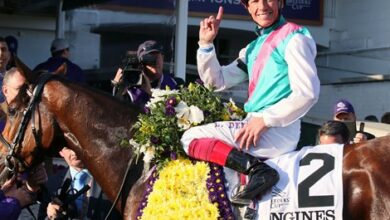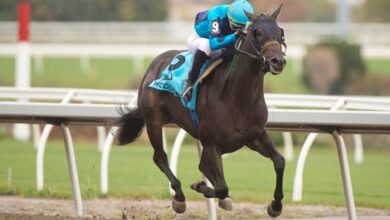From Magazine: Giving Bettors Fighting Chance vs. CRW

In a rare move to provide some cover for United States horseplayers in a pari-mutuel game currently dominated by high-volume players that use computer algorithms to find value in pari-mutuel wagering pools and then back those opinions with billions of dollars in wagers a year, the New York Racing Association has called for some boundaries.
NYRA in the summer of 2021 restricted win-pool wagers from so-called computer-robotic wagering teams to no later than three minutes before post. This policy followed earlier changes by NYRA to ban CRW teams from its Pick 6, late Pick 5, and Cross Country Pick 5 pools.
For major tracks in the U.S., NYRA’s move is about as rare as a 100-1 winner. In recent years the U.S. industry has rolled out the red carpet for CRW players, providing them with significant access and advantages, including access that allows their algorithms to search available pools for value and estimate value in other pools, being the last bettors into those pools, ability to express their opinion through hundreds of wagers in an instant, and the best rebates—money returned from the host platforms accepting the wagers to these bettors for their significant action.
For more stories like this one, Subscribe to BloodHorse Magazine
The approach has proved a success in attracting and keeping the high-volume CRW players but might be driving off many other small- mid- and high-level bettors. The premise isn’t hard to understand: In pari-mutuel wagering, as in the physical world, every action has a reaction. This is because in pari-mutuel wagering, bettors are competing against one another for winnings so that when one group of bettors benefits, other segments are negatively impacted.
Mike Cancilla is one of those non-CRW bettors that have been impacted. For years, New York-based Cancilla has participated with a team of bettors that pumps millions of dollars a year into pari-mutuel pools. He said in recent years that team has dwindled from about 80 players to 60 players as members leave the group, sometimes complaining that pari-mutuel wagering has become too difficult.
“Players have left to focus on sports betting and new players aren’t coming in,” Cancilla said.
In this world of whales, Cancilla’s handle pales to that of the CRW teams—they typically are teams of players as opposed to individuals. While his group bets millions a year, the CRW players wager billions. Cancilla thinks CRW teams effectively are playing a different game. While he does receive rebates, he said they are smaller than CRW teams and he’s not afforded the access advantages.
“It feels like we’re being cheated. People are leaving the game; it’s not just talk,” Cancilla said. “At some point, if enough of us leave, the (CRW) teams won’t have anyone to take money off of. I welcome the NYRA changes, but I want the (CRW) players barred. I don’t want them in any of the pools.”
Cancilla is right that CRW players need a certain level of liquidity provided by other players. For instance, CRW teams typically don’t pour money into tracks with smaller pari-mutuel pools—instead they stick to the big pools offered at the major circuits.
Pat Cummings, executive director of the Thoroughbred Idea Foundation, which advocates for horseplayers and owners, estimates CRW teams account for about 33% of the handle on U.S. races, which through November was on pace to surpass $12 billion (for 2022). He said the industry’s efforts to keep CRW teams happy has come at the cost of traditional horseplayers.
“In some of our ongoing research that we will publish in the near future, we have found race days where the biggest CRW teams have a profit in excess of 60% for the day and all the customers of mainstream ADWs have lost over 50% for the day—more than double the blended takeout rate,” Cummings said. “You would like to think tracks look at their own wagering data and identify that such outcomes are remarkably unhealthy for the sport and its wagering business, no matter how isolated such days may be.”
NYRA vice president for communications Pat McKenna said its moves are aimed to prioritize the everyday horseplayer who supports racing 12 months a year. The move to require CRW players to place any win wagers at least three minutes before the race also addresses one of the other big problems caused by CRW players—late odds shifts in the win pool. Because CRW players are betting massive amounts of money at the last possible moment, win odds at tracks can shift dramatically even after the gates open as the pari-mutuel system struggles to update the information following the flood of last-second money.
While the industry requires protocols to ensure wagers are made before the gates open, the handle takes some time to register in the system and odds shift during the race. Cummings tweeted about one race at Keeneland in October (2022) where the amount reported in the win pool after the gates opened was higher than that reported before the race started. Obviously, as those pools determine the odds, this type of situation can result in massive changes from the expected odds by bettors and the actual odds when the horses reach the wire. Those changes make it difficult for horseplayers to determine any perceived value as a horse they play at 7-2 might ultimately pay off at 2-1.
“To align with NYRA’s goal of prioritizing the interests of the everyday horseplayer, NYRA has taken significant steps in recent years regarding (CRW) involvement within NYRA pools,” McKenna said. “In addition to the establishment of retail only multi-race wagers—including the Pick 6, Late Pick 5, Cross Country Pick 5 and Triple Play—NYRA took the unprecedented step in 2021 to require (CRW) groups to enter win bets by three minutes to post. As a result, NYRA has effectively eliminated the dramatic late odds shifts that had become a source of frustration to bettors in New York and around the country.”
It’s notable that after making the changes to put a few limits in place on these high-volume players, NYRA has continued to enjoy strong handle.
“These changes have resulted in more equitable opportunities for the broad range of horseplayers playing the NYRA product,” McKenna said. “At the same time, and as evidenced by record-breaking wagering this summer at Saratoga, overall interest and wagering on the NYRA circuit remain strong.”
Action, Reaction
With an average takeout for all wagers in the 20%-21% range, racing already is a tougher proposition than poker or sports wagering. Cummings’ examination of CRW wagering suggests these high-volume bettors are effectively increasing that already high takeout for all other players.
Facing these high hurdles, it’s clear that non-CRW players have left the game and new blood is not replacing them. If a third of handle is coming from a few CRW teams, that would represent about $4 billion, which means everyone else is betting about $8 billion. In 1990, an era before CRW wagering soared, about $9.4 billion was wagered on U.S. racing. This story won’t even get into inflationary numbers, which would make that stat even more distressing.
Even if horseplayers don’t completely understand takeout or the impact of CRW players, they have a feel for when they are up against it. At a 2018 symposium on the challenges and opportunities for racing as the legal sports betting market emerges, Ed Hannah of The Stronach Group, said in the mobile and online atmosphere, bettors have an understanding of takeout based on how often they have to replenish their accounts.
For more stories like this one, Subscribe to BloodHorse Magazine
“People putting money in their deposits will notice that difference,” Hannah said, explaining that because of takeout, the average sports bettor can make a $100 deposit last much longer than the average horseplayer. “We have to do a lot of thinking about (takeout).”
He called for lower pari-mutuel takeout to be more in-line with the lower takeout enjoyed in fixed-odds sports betting. It should be noted that those lower-takeout games provide ready-made outlets for horseplayers frustrated by the current pari-mutuel landscape.
CRW Impact
A BloodHorse examination of the Pick 5 pools at last summer’s Saratoga Race Course meeting suggests NYRA’s policies do provide some value for non-CRW players and points to how CRW players mine the value from pools they target.
NYRA’s early Pick 5 allows CRW players while the late Pick 5 does not allow CRW players. With both pools carrying a 15% takeout, they seem ripe for comparison. BloodHorse compiled the full list of 50-cent payoffs for the early Pick 5 and the late Pick 5 for each day at the meet. Then, to allow for comparison of the two, BloodHorse determined what the win parlay would be for the five races in each sequence.
The win parlay would be the amount bettors would receive if they made a winning bet on the first race in the sequence, say $2, and then bet back those winnings on each race that followed. Say the $2 on the first race returned $7, the win-parlay would then see that $7 bet again and maybe it returns $21, and then that $21 returns $105, and so on. In general, such wagers as the Pick 5 pay better than a win parlay because the bettor is only exposed to the takeout one time instead of being exposed to takeout rates for all five win wagers.
For easy comparison, BloodHorse determined the win parlay at the 50-cent level as that’s the bet level listed for winning Pick 5 payouts. Also, BloodHorse eliminated a small number of sequences in which the Pick 5s effectively were turned into shorter sequences when “all” bettors were advanced in the Pick 5. This occurs, by rule, in a few situations, including when a late surface change is announced.
The study found that the late Pick 5, where CRW players are not allowed, returned 3.8-times the expected win parlay while the early Pick 5, where CRW players are allowed, returned just 1.2-times the parlay. For the “everyday” players allowed in the late Pick 5, that pool provided significantly more value than the early edition of the wager.
Kentucky Horse Racing Commission records on handle and winnings for on-track wagering on live races at the state’s tracks also points to the impact of CRW players. Looking at KHRC fiscal years 2022 and 2023 through September (July 1, 2021-Sept. 30, 2022), on-site bettors at Thoroughbred and Standardbred tracks saw just $76,448,621 in winnings returned from $105,736,132 in wagers. That is to say the effective cost (takeout) of betting races on-track in Kentucky was 27.7 cents for each dollar wagered. (On-track players, which would not be CRW players, are competing against those CRW bettors.)
In general, pari-mutuel takeout rates in racing have increased over the years, but that spike doesn’t completely account for what’s going on here. After all, these on-track players are losing well more than that estimated 20-21% blended takeout rate. The take-home: On-track horseplayers are losing their shirts.
Here’s a breakout of the effective takeout rates (what players paid per dollar wagered) for on-track players at the five Kentucky Thoroughbred tracks during this period: Churchill Downs 30.3%, Ellis Park 26.2%, Keeneland 24.2%, Kentucky Downs 18.6%, and Turfway Park 25.1%. The better performance by horseplayers at Kentucky Downs can be attributed to its lower takeout rates compared with those at the other Kentucky tracks.
Cummings believes the added losses also can be attributed to on-track bettors wagering on heavily marketed higher-takeout wagers (typically plays involving multiple horses or multiple races, including jackpot-type wagers), as well as bettors’ increased exposure to CRW teams, especially in these pools. He estimates CRW play accounts for as much as 40% in some of the multi-race and multi-horse pools. And those jackpot wagers and exotic pools are where many on-track players are taking their shots. As these successful CRW teams win, it increases the effective takeout rate for the losing players on-track.
In July 2020, TIF published a white paper listing concerns about racing’s approach of catering to the CRW teams. The paper’s title simultaneously referenced a leading CRW platform, Elite, and the levels of players in its headline “Racing Not Only for (the) Elite.” Its content outlined how studies, as early as a 2004 report from the NTRA Wagering Systems Task Force, outlined how catering to CRW players figured to make pari-mutuel wagering less attractive for all other players.
Just as that NTRA report eventually would be ignored, Cummings said the TIF white paper made little impact with tracks.
“I’d say the CRW play has increased since the report,” Cummings said.
It might seem surprising that an organization, TIF, that in-part represents owners, would call for policies that on the surface could negatively impact handle. But TIF believes that the best way to increase handle long-term is by attracting more bettors to the game, which, long-term, would increase purses and boost tracks’ bottom lines. It’s important to note that CRW teams are rebated at such a rate that their handle generates a much smaller percentage of money for purses and tracks when compared with all other wagers.
“The race-wagering playing field, if you will, has grown significantly uneven in the last two decades,” Cummings said. “The biggest growth in customer dollars wagered has come from the CRWs and they are filling the void left by horseplayers that have either stopped betting racing by choice, decided to bet on something else, or passed away. That’s the reality.”
Besides NYRA’s efforts, other small steps have been taken. Some ADW sites allow smaller players to enjoy some of the advantages CRW customers already have, such as setting odds parameters and allowing batch wagers. Cummings believes the sport has to find ways to keep more of its players—the players who still are by far the most in number—satisfied.
It’s a critical time for race wagering. With sports betting proliferating, tracks have landed race wagering on sports betting platforms where players will get a first-hand comparison between sports wagering, where bettors lock-in odds and face low takeout, and pari-mutuel wagering, where they’ll face fluctuating odds, a higher takeout, and competition from CRW players.
“Simply getting racing on mainstream sports betting apps is not going to solve the problem of building a modern base of new horseplayers. We have to reinvent bet types, tote technology, introduce new betting markets, modernize every aspect of wagering to compete in what is the most competitive space ever for consumers’ discretionary spending,” said Cummings, who also has called for racing to move into fixed-odds wagering to attract those sports bettors familiar with that type of wager. “What is the greater industry doing for the average horseplayer?”




